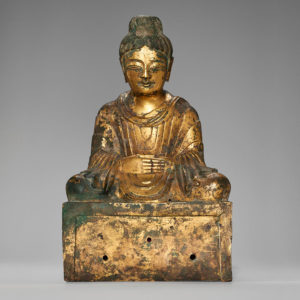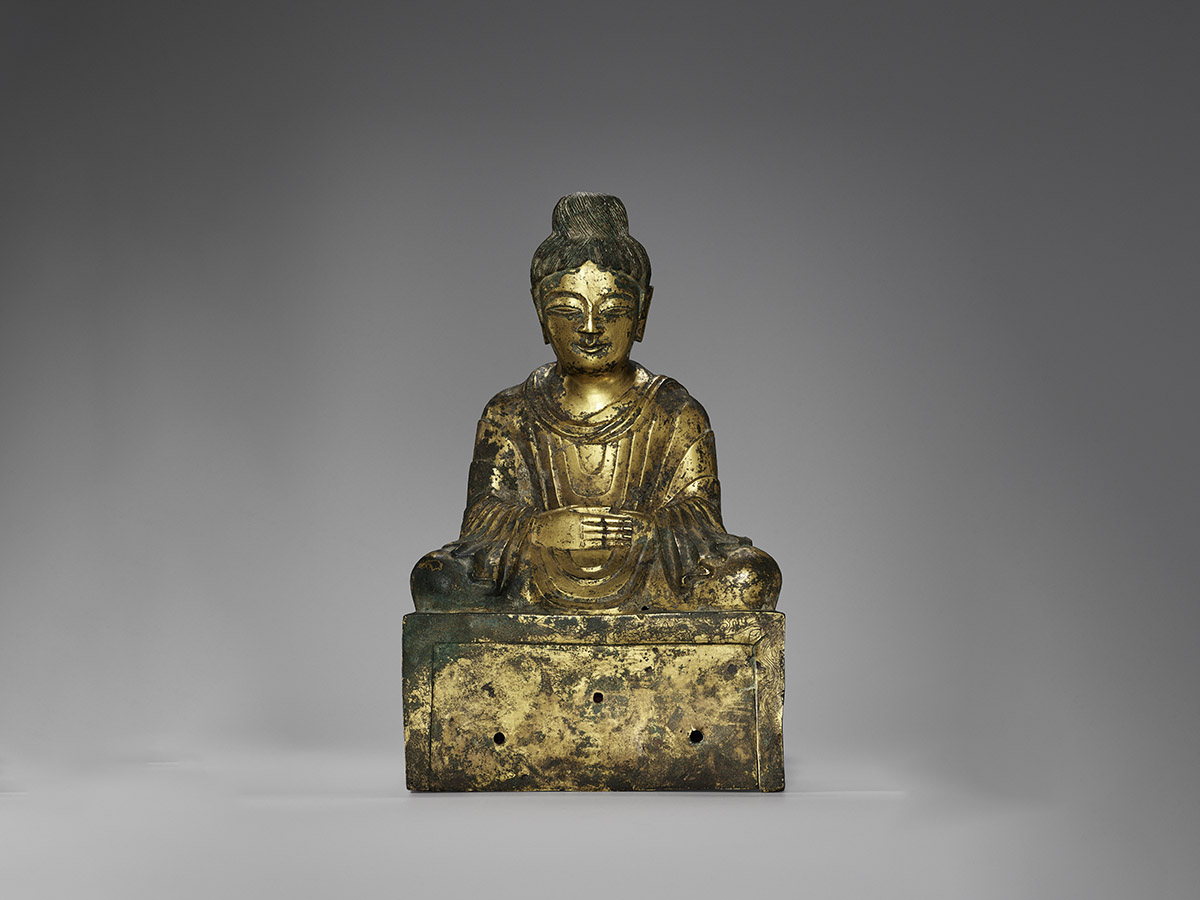China’s earliest known dated Buddha tells the story of early Buddhist art in China.

Buddha dated 338
China; Hebei province
Later Zhao kingdom (319–351)
Bronze with gilding
The Avery Brundage Collection, B60B1034
Made 400 years after Buddhism was introduced to China from India, this is the earliest known dated Buddha sculpture produced in China. At about 16 inches tall, it is among the largest bronze sculptures to have survived from the era and was cast using sophisticated techniques for its day. Although it shows the stylistic influence of the art of ancient Gandhara (a region now largely in Pakistan that connected trade routes between Europe and Asia), Chinese characteristics make this statue an important milestone in the development of Buddhist art in China.

In the second century, Buddhist monks from the Indian subcontinent had begun translating Buddhist texts from Sanskrit to Chinese. But it was only after the collapse of the Han dynasty in 220 that Buddhism grew in popularity throughout China. The religion offered an end to the cycle of suffering to all levels of society, which may have been particularly appealing during this time of social and political upheaval.
The inscription attributes this sculpture to the Later Zhao, a northern state founded by a non–Han Chinese people from Central Asia who controlled China’s Central Plain during the first half of the fourth century. The state’s rulers regarded the Indian monk Fotudeng (died 348) as their principal religious counsel and military adviser in the campaigns they undertook to extend their territory. Fotudeng arrived in the Central Plains in 310, preaching the Buddhist faith and seeking converts. He was trusted by Later Zhao rulers as a miraculous and venerated master. To worship Buddha for blessings of victory, these non-Han rulers commissioned the building of large-scale temples, the construction of ornamented grottoes, and the mass production of Buddhist statues.
Fotudeng may have inspired Shi Hu, the third king of the Later Zhao, to commission statues like this one. In 338, the year this Buddha was produced, Shi Hu captured more than forty cities in the Central Plain.
The Buddha dated 338 shares stylistic elements with sculptures from Gandhara, a region largely in modern Pakistan. Scholars theorize that small sculptures along with Buddhist texts and paintings were carried into China, inspiring artists there.
There are significant debates concerning when and why the first images of the Buddha were created, and they likely predate this work by a few hundred years. Few early Buddha images have inscribed dates, making this rare Buddha statue extremeley important for the study of early Buddhist art.
The earliest Buddha images came from Mathura in central India and Gandhara to India’s northwest. A cosmopolitan region with strong ties to the Greek and Roman world, ancient Gandhara connected trade routes between Europe and Asia. Gandharan art shows echoes of eastern Mediterranean art that rippled out to China.
Scholars see compelling comparisons with Gandharan sculptures in the Buddha dated 338’s posture, particularly the legs crossed beneath a draping robe.
Chinese characteristics make this statue an important milestone in the development of Buddhist art in China. The figure’s arrangement, with legs crossed beneath an evenly draped robe and set on a rectangular pedestal, is probably modeled after a Central Asian prototype brought to China via the Silk Road. However, this Buddha’s overlapping, inward-facing palms are adopted from a formal Chinese gesture of reverence. His face, hairstyle, robe, and throne have also been adapted according to Chinese preferences to attract native devotees, especially his charming smile and removed moustache.
The fragmentary inscription on the back of the base indicates this statue belonged to the Later Zhao (319–351), a kingdom founded in Hebei by a nomadic people who eventually controlled most of northern China. It was in this kingdom where Buddhism became a state-sponsored, widespread religion after being a minority religion for hundreds of years.
The partial inscription on the base reads: 建武四年, 歲在戊戌, 八月卅日, 比丘竺 . . . 慕道德 . . . 及三 . . . 生。In the fourth year of the Jianwu reign era (338), the year of wuxu, on the 30th of the eighth lunar month, a monk named (Zhu) . . . respect moral and virtue . . . and three . . . livings.
This Buddha would have been placed on an altar for personal devotion. The holes on its base and head are evidence that this Buddha is missing some of its parts. Other Chinese bronze Buddha figures produced around the same time offer clues as to what this sculpture may have looked like in its original glory.
The square protrusion at the back of the head likely supported a halo, symbolizing the Buddha’s enlightenment. The hole at the top of the head would have held a parasol, an auspicious symbol often associated with royalty. The three holes at the front of the base may have secured a lotus — also symbolizing enlightenment — and a pair of lions. Associated with regality, strength and power, the lion is one of Buddhism’s most powerful symbols. In fact, the Buddha’s teachings are sometimes referred to as the “Lion’s Roar.”
Most of this sculpture’s surface is gilded using a technique known as mercury gilding. Its size makes it one of the most accomplished and costly surviving from its time. The gilded surface is produced by applying a pasty mixture (amalgam) of gold and mercury. Heating over a fire evaporates the mercury, releasing toxic fumes, and leaving the gold bonded to the surface. This gold surface is then burnished with a hard, smooth metal or stone tool to make it shiny and more compact. Today, mercury amalgams are more commonly known for their use in repairing dental cavities.
A 2010 study revealed that the Buddha dated 338 was cast with leaded bronze using the piece-mold technique. A marker of this process is the use of square bronze chaplets or spacers. In piece-mold casting, a clay model is first made of the object, then a clay mold is created from the model. The mold is cut into sections, which are reassembled around a core (often of clay) to form the mold for casting. Molten bronze is then poured between the mold and the core. Once cooled, the mold and core are broken to reveal the object.